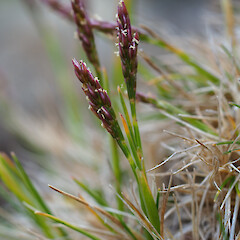Agrostis subulata
Synonyms
None
Family
Poaceae
Flora category
Vascular – Native
Endemic taxon
Yes
Endemic genus
No
Endemic family
No
Structural class
Grasses
NVS code
The National Vegetation Survey (NVS) Databank is a physical archive and electronic databank containing records of over 94,000 vegetation survey plots - including data from over 19,000 permanent plots. NVS maintains a standard set of species code abbreviations that correspond to standard scientific plant names from the Ngä Tipu o Aotearoa - New Zealand Plants database.
AGRSUB
Current conservation status
The conservation status of all known New Zealand vascular plant taxa at the rank of species and below were reassessed in 2017 using the New Zealand Threat Classification System (NZTCS) – more information about this can be found on the NZTCS website. This report includes a statistical summary and brief notes on changes since 2012 and replaces all previous NZTCS lists for vascular plants.
Please note, threat classifications are often suggested by authors when publications fall between NZTCS assessment periods – an interim threat classification status has not been assessed by the NZTCS panel.
- Conservation status of New Zealand indigenous vascular plants, 2017 . 2018. Peter J. de Lange, Jeremy R. Rolfe, John W. Barkla, Shannel P. Courtney, Paul D. Champion, Leon R. Perrie, Sarah M. Beadel, Kerry A. Ford, Ilse Breitwieser, Ines Schönberger, Rowan Hindmarsh-Walls, Peter B. Heenan and Kate Ladley. Department of Conservation. Source: NZTCS and licensed by DOC for reuse under the Creative Commons Attribution 4.0 International licence.
2017 | At Risk – Naturally Uncommon | Qualifiers: RR
Previous conservation statuses
2012 | At Risk – Naturally Uncommon | Qualifiers: RR
2009 | At Risk – Naturally Uncommon | Qualifiers: IE
2004 | Range Restricted
Distribution
Endemic. Auckland Islands and Campbell Island/Motu Ihupuku.
Habitat
Peat covered rock ledges and sills, herbfields and in Chionochloa antarctica (Hook.f.) Zotov grassland.
Detailed description
Small, densely tufted perennial 30–90 mm tall, with rigidly erect glaucous leaves usually overtopping the light green, spicate panicles. Branching intravaginal. Leaf-sheath light brown, more or less hyaline, strongly ribbed, finely scabrid particularly near margins. Ligule 0.8–1.0(–1.6) mm, margins denticulate, undersides scabrid. Leaf-blade 15.0–40.0 × 0.3–0.6 mm, firmly fleshy, inrolled, strongly ribbed, finely and closely scabrid, apex blunt. Culm hidden within leaves, erect, internodes scabrid. Panicle 10–20 mm long, condensed, tightly oblong; rachis, branches and pedicels erect, closely short-scabrid. Spikelets 2.0–3.3 mm. Glumes subequal, lanceolate, pale green, occasionally tinged with purple, surfaces with antrorse prickle-teeth or minutely hairy, consistently glabrous near base. Lemma 1.3–1.6 mm long, glabrous, prominently 5-nerved, ovate, truncate, minutely denticulate, margins finely scabrid near apex, without awns or rarely with a fine awn arising c.2 mm from the upper third of midnerve. Palea 0.3–0.4 mm, ovate. Lodicules 0.4 mm long. Callus glabrous. Anthers 0.4–0.7 mm long. Seed 1.0 × 0.5 mm.
Manaaki Whenua Online Interactive Key
Similar taxa
Agrostis muelleriana which is confined to the North and South Islands of New Zealand and Australia and differs by the deep reddish purple rarely green glumes smooth or papillose, with the keels finely scabrid.
Flowering
unknown
Fruiting
unknown
Life cycle
Florets are dispersed by wind and water (Thorsen et al., 2009).
Propagation technique
Has not been cultivated. Probably easy from fresh seed and rooted pieces but likely to require cold treatment to flower. Unlikely to tolerate warm, humid conditions.
Threats
An uncommon narrow range endemic.
Etymology
agrostis: Greek name for a kind of grass
subulata: From the Latin subulam ‘awl’, meaning awl-shaped
Where To Buy
Not commercially available
Attribution
Description modified from Edgar and Connor (2000).
References and further reading
Edgar E, Connor HE. 2000. Flora of New Zealand. Vol. V. Grasses. Christchurch, Manaaki Whenua Press. 650 p.
Thorsen MJ, Dickinson KJM, Seddon PJ. 2009. Seed dispersal systems in the New Zealand flora. Perspectives in Plant Ecology, Evolution and Systematics 11: 285–309.




